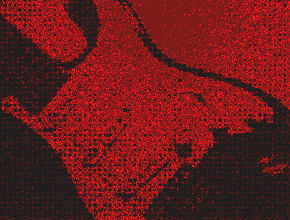Note: This is part of a series commemorating the 25-year anniversary of the band Meshuggah by exploring the roots and legacy of Meshuggah’s style of progressive metal rhythm.
The groove metal band Pantera may not seem like an obvious choice for a series of posts about Meshuggah and progressive metal. Pantera began their career in 1981 as a power metal band that performed in spandex and had huge hairdos. In 1987, Pantera switched out their lead singer and started developing a new visual brand and playing style. ((This parallels a general shift across many heavy metal genres away from the flamboyance and theatrics of 70s stadium rock and glam metal, towards a cultivated every-day look and dirtier sound. A notable recent book that tells the whole story is Ian Christe’s 2004 Sound of the Beast: The Complete Headbanging History of Heavy Metal, although his claim that Pantera “fused metal and rap in a more fluid manner than Anthrax” (p. 229) is misleading at the very least, given that vocalist Anselmo demonstrates disdain and near-complete ignorance of rap and hip-hop in many interviews.)) “Diamond” Darrell switched his nickname to “Dimebag,” and the band ditched the leather and the hairspray in favor of t-shirts and jeans. Musically, the new lead singer Phil Anselmo began using a rough, more growled delivery style instead of a power metal falsetto, and the band’s music began to take a few cues from thrash metal bands like Metallica.
But the most influential and innovative part of Pantera’s new playing style was their approach to rhythm in their riffs. They borrowed from the aggressive, percussive approach to playing the guitar that you can hear on some of Metallica’s heaviest songs, with lots of bottom-heavy palm-muted guitar accents and a few string bends. Sometimes, like on the song “Heresy,” they actually sound a bit like Metallica. But on quite a few songs, Pantera uses riffs with syncopated, off-beat rhythms that groove much more than anything Metallica ever wrote. When I say that Pantera is groovy, however, I don’t mean that they are anything less than heavy — in fact, even though Pantera strays farther from the beat than most thrash metal bands, their heavier songs are more visceral than Metallica. (That’s my opinion, maybe not yours — let me know if you agree in the comments!)
Continue reading

